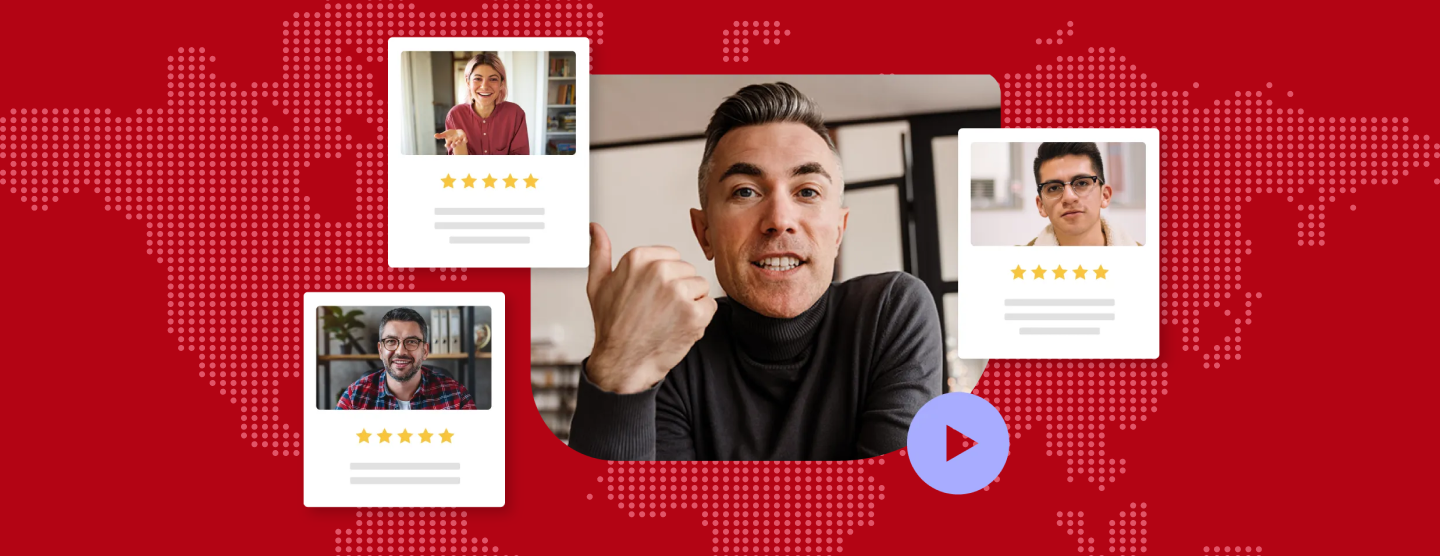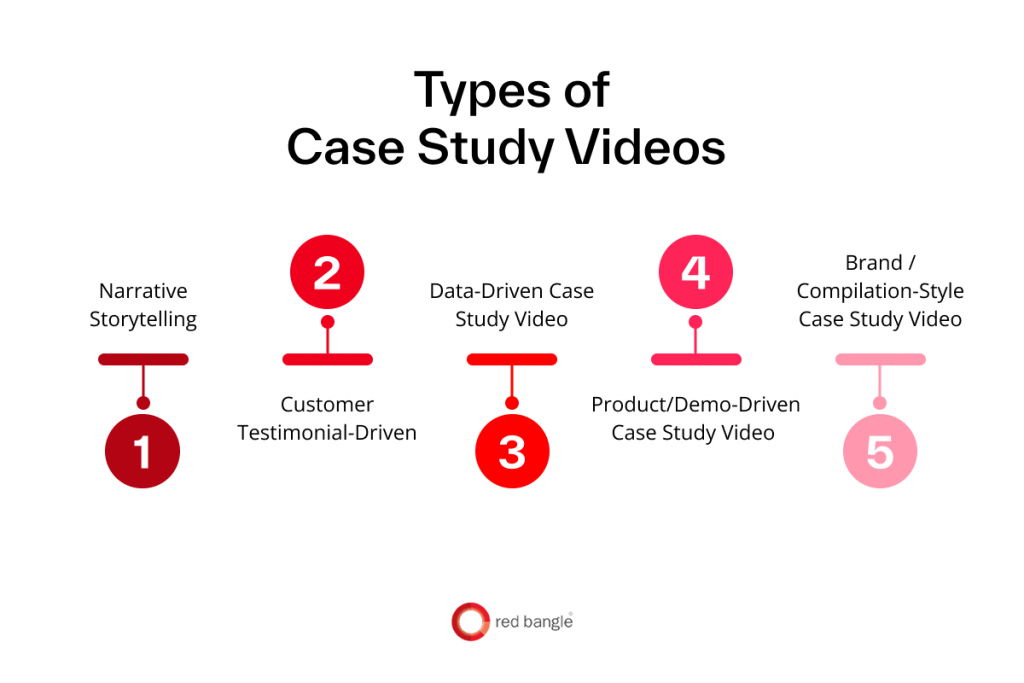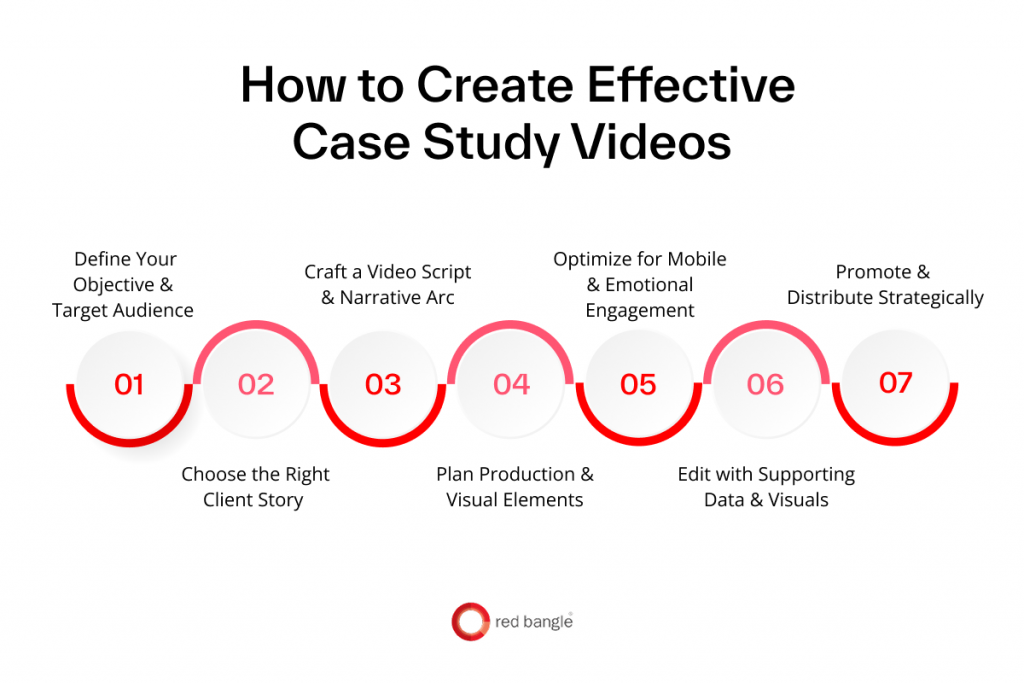Case Study Videos: How to Create Stories That Convert
Case study videos turn happy customers into your strongest proof. See how real stories backed by outcomes, data, and emotion build trust, differentiate your brand, and speed decisions. Learn formats, a step-by-step production plan, and distribution plays that drive conversions.

Introduction
You’ve got the testimonials. You’ve got the numbers. But when it comes to persuading that warm lead sitting on the fence, words on a slide just aren’t enough anymore.
At this stage of the funnel, your prospects don’t need more education. They need confidence. They need proof. And ,they need to feel the success of someone like them choosing your solution and winning because of it.
That’s where case study videos shine.
Take a look at this Wipro payer vertical case study; you’ll understand why and how.
The video, created by Red Bangle, is not just about automation or AI. It’s about how a massive healthcare payer reclaimed control over its claim processes, saved time, and transformed member experiences.
Through real visuals and clear outcomes, Wipro built a story that felt human and credible. That’s exactly what decision-makers are looking for.
In this guide, you’ll know how case study videos can become a powerful marketing asset to target those decision-makers.
We’ll walk you through the business case, effective formats, step-by-step production, and distribution strategies that actually move the needle. If you’re ready to turn happy customers into powerful storytellers and your biggest advocates, let’s dive in.
Why Case Study Videos Matter for Businesses
Case study videos showcase real customer stories, highlight problems solved, and demonstrate measurable results. These videos build trust, validate claims, and influence buying decisions.
Brands use case study videos to share authentic success stories that educate audiences and shorten sales cycles. They combine storytelling, visuals, and data to present compelling proof of value.
Case study videos serve as powerful marketing tools for B2B companies seeking credibility and engagement. But beyond the definition, here’s the core idea: these videos are not just content. They are proof.
And in B2B, proof makes the difference.
Notably, users requesting case studies are 78.5% more likely to make a purchase decision within the next 12 months, reinforcing how powerful video proof really is.
Let’s explore why these videos work so effectively in B2B marketing.
1. Build Trust & Social Proof
In B2B buying, trust is everything. When prospects watch someone in their industry speak candidly about results, it hits differently than a static case study PDF.
Video adds layers of credibility: tone of voice, facial expression, and authentic emotion that text alone can’t capture. By letting prospects hear success stories directly, you create resonance and relatability, which is especially powerful for high-stakes purchases.
2. Differentiate in Competitive Markets
In crowded industries where features and pricing look almost identical, differentiation often comes down to how you tell your story. A well-produced case study video does more than highlight outcomes; it showcases your brand’s culture, approach, and values.
For example, a SaaS company might emphasize not just faster implementation but also how its collaborative process made the client feel supported throughout. This depth of storytelling becomes a competitive advantage, giving you an edge when buyers struggle to see clear distinctions between vendors.
3. Accelerate B2B Decision-Making
Case study videos don’t just build trust; they speed up decisions. Prospects are naturally risk-averse, and no amount of product sheets can completely ease that hesitation. But when they see another company (ideally similar in size, industry, or challenge) achieve measurable success, the perceived risk drops significantly.
These videos deliver reassurance in a format that is quick to consume, persuasive, and memorable, often shortening the sales cycle by giving buyers the confidence to move forward.
For us at Red Bangle, this is exactly where we shine: turning proof into persuasion. Over the years, we’ve helped Fortune 500s and startups capture customer success stories with the clarity, consistency, and credibility that decision-makers look for. A big part of how we deliver this is through our proprietary Creative Cloud platform, which streamlines briefs, production workflows, reviews, and asset management.
As our founder, Lakshmi Rebecca, puts it, “Our platform is what keeps clients from ever having to chase us on deadlines or files. Everything is organized, reviewed, and delivered with precision.”
Types of Case Study Videos
As per Content Marketing Institute 2024 research, B2B marketers rate videos as the most effective content format (58%), with case studies/customer stories close behind at 53%. Put together, you create case study videos that combine the credibility of customer stories with the persuasive power of video.
Below are five effective video formats that B2B teams use to highlight customer success, build credibility, and accelerate decision-making.

1. Narrative Storytelling
This is your most cinematic, brand-building format. It uses a structured voiceover, high-quality footage, and a strong narrative arc to guide viewers through a customer journey that feels as much emotional as it is operational. These videos place your product within a larger story of change, resilience, or transformation.
When to use
This format works best when your audience needs to feel something before they buy into it. It’s often used in high-value sales, brand repositioning, or when targeting enterprise executives who value strategic alignment and emotional context.
Pros: Strong emotional resonance and high-impact brand positioning
Cons: Requires more planning, scripting, and production investment
Example: Infosys – A Covid-19 Case Study Video
- Company/Product: Infosys with a mining client during the COVID-19 crisis
- Video Format: Cinematic live-action with voiceover
- What Makes It Work:
The video, created by Red Bangle, begins by framing the challenge through a global crisis. Workers needed protection. Operations needed continuity. Infosys’ COVID-19 screening app is introduced not as software but as a safeguard for people. The story transitions from uncertainty to empowerment, and finally to resilience.
We see frontline workers using the app, leaders interpreting real-time data, and the larger impact of 100,000+ screenings per week. The pacing, visuals, and tone reflect urgency, capability, and care.
- Key Takeaway
This format transforms your product into a character in a larger story. It positions you as more than a vendor. For executive decision-makers and strategic buyers, this format elevates your relevance.
Use narrative storytelling when your customer journey includes significant transformation, emotion, or long-term outcomes.
At Red Bangle, we love crafting these high-emotion narratives. Our process is set up to guide clients from brief to storyboarding to execution, ensuring we capture not just the technical wins but also the human moments of change. Because for us, the most powerful videos are those that let audiences feel transformation.
2. Customer Testimonial-Driven
This format puts your customer at the center. In their own voice. No scripts, no filters. Just a direct reflection on their experience and impact. It’s the closest thing to a personal referral, and that makes it incredibly powerful.
When to use
This approach is perfect when authenticity and relatability are more persuasive than polish. It’s ideal for SaaS, services, or consulting use cases where customer experience speaks volumes.
Pros: Quick to produce and deeply relatable
Cons: May lack visual variety if not supported by B-roll or editing
Example: Slack helps reMarkable rewrite the rules of IT
- Company/Product: Slack with reMarkable
- Video Format: Interview-led with real-world footage
- What Makes It Work
The story is told by reMarkable’s team in their own words. They don’t just talk about Slack features. They talk about momentum, innovation, and creative flow. That emotional language lands differently. It’s not a pitch. It’s a reflection.
We’re introduced to “Agent Saga,” an internal AI Slack bot that transforms how tickets are created and managed. But the real message is about how people feel using it: faster, clearer, more empowered. The entire video feels unscripted, natural, and human.
- Key Takeaway
Real voices connect. Especially when your product is woven into daily work habits. This format is perfect for video testimonials and warm lead conversion assets. Use it when you want buyers to hear what success sounds like from a peer.
3. Data-Driven Case Study Video
This format is about clarity, structure, and outcomes. It centers on metrics, results, and efficiency. With visual charts, text overlays, and animated flows, the goal is to prove performance in a way that builds confidence in logic-driven decision-makers.
When to use
Best suited for technical, compliance-focused, or ROI-conscious buyers. These are stakeholders who want to see the numbers before they say yes.
Pros: High credibility and easy to follow
Cons: Needs design and pacing to stay engaging
Example: Wipro Animated Explainer – HIMSS 2020
- Company/Product: Wipro and a healthcare client
- Video Format: 2D animation with motion graphics and text overlays
- What Makes It Work
The case study video frames the problem quickly: cybersecurity risks in healthcare. From there, Wipro’s layered defense system is broken down visually. We see threat modeling, attack paths, remediation tools, and system-wide tracking.
There’s no fluff. Every visual reinforces a point of action or improvement. Red Bangle, the creative agency behind it, made sure that vulnerability metrics are not just mentioned; they’re shown as before-and-after visuals. The storytelling is minimal, but the precision is high.
- Key Takeaway
When results matter more than story, this format delivers. It works especially well for B2B case study videos focused on performance, compliance, or system transformation.
Use this when you’re talking to CIOs, CISOs, or procurement teams who need quantifiable justification to move forward.
4. Product/Demo-Driven Case Study Video
This is your “show me how it works” format. It’s part customer story, part feature walkthrough. These videos put your solution on display and tie it directly to impact. They help remove friction by making functionality feel real and accessible.
When to use
Ideal for mid-to-late stage funnel moments where buyers are comparing vendors and need clarity on workflows, usability, and adoption.
Pros: Practical, visual, and grounded in real use
Cons: Needs a storyline to avoid feeling like a product tutorial
Example: Infosys x WSJ Kia e-Delivery
- Company/Product: Infosys with Kia America
- Video Format: Mixed media, product walk-through, client voiceover
- What Makes It Work
This video by Red Bangle shows how Kia digitized its entire vehicle delivery experience. From pre-delivery inspections to onboarding guides, we see features in use. But the framing isn’t technical. It’s human.
Sales reps are empowered. Customers receive digital experiences from day one. JD Power scores improve. The product is not just shown. It’s connected to value, people, and process improvements.
- Key Takeaway
Product-driven videos help prospects imagine implementation in their own world. They remove guesswork. If your buyer asks what setup or day-one impact looks like, this format answers clearly.
5. Brand / Compilation-Style Case Study Video
This format compiles multiple success stories into one. You’re not diving deep into one client’s journey. You’re showing volume, breadth, and repeatability. It’s a credibility asset that signals you’re built to scale.
When to use
Use this for enterprise sales, leadership presentations, or when entering new markets. It’s less about a single story and more about showing strength in numbers.
Pros: High-volume proof, global reach, and authority-building
Cons: Not ideal when deep emotional storytelling is required
Example: Red Bangle Fortune 500 Case Study
- Company/Product: Red Bangle with a global ITES company
- Video Format: Multi-client montage
- What Makes It Work
This video covers hundreds of outputs like explainers, brand films, recruitment videos, and more. It shows how Red Bangle delivers at scale, across geographies, functions, and formats. Instead of one storyline, you get a dozen quick snapshots of impact.
What’s powerful is the rhythm. It’s fast-paced but cohesive. It communicates trust, capacity, and versatility in one hit. Perfect for C-level stakeholders who want reassurance that you can do this again and again.
- Key Takeaway
This is your “proof at scale” format. If your value proposition includes repeatability, versatility, or global execution, this style is your best fit.
Also read → 3 video formats proven to drive customer acquisition across the funnel for B2B businesses.
How to Create Effective Case Study Videos (Step-by-Step Guide)
You’ve chosen the format, locked your strategy, and structured your story. Now it’s time to bring your case study video to life, from client selection to final promotion.
Each stage here reflects proven practices from top B2B video teams and marketing frameworks, simplified into actionable steps you can repeat for every future video.

1. Define Your Objective & Target Audience
Every successful video starts with a clear purpose and viewer profile. Without this, even great storytelling can miss the mark.
- Objective first
Decide exactly what you want this video to achieve. Is it about closing warm leads? Getting buy-in from procurement? Supporting expansion conversations?
- Audience clarity
Are you speaking to the economic buyer, the technical evaluator, or the daily user? Each persona will respond differently to tone, pacing, and content depth.
- Map tone to intent
For example, C-level viewers expect tight messaging and strategic value. Practitioners may need more visual proof and workflow walkthroughs.
This clarity will shape everything from scripting to post-production. A well-targeted case study video feels like it was made just for the viewer because it was.
2. Choose the Right Client Story
Not every happy customer makes a great video subject. You need a story that mirrors your ideal prospect’s situation and makes success feel both relatable and repeatable.
- Look for relevance, not just results
A recognizable name helps, but what’s more valuable is fit. Does this client reflect your target industry, use case, or growth stage?
- Prioritize clients with a clear before-and-after
Transformation stories work best when the viewer can clearly see where the customer started and how far they’ve come.
- Get internal buy-in early
Reach out to the client with a brief, get their legal or brand team looped in, and align on timelines. Delays often happen here, so proactive communication matters.
The goal is to feature a customer who makes your future buyer say, “That sounds like us.”
That’s why at Red Bangle, we spend extra time upfront advising clients on the right story fit. Many times, we’ve helped marketing teams refine briefs and even guided them toward the right kind of video format, whether it’s a testimonial, a demo, or a narrative, so the story lands perfectly for their budget, audience, and goals.
As our founder, Lakshmi Rebecca, often says, “We don’t just make the video you ask for, we help you figure out the video you actually need for the impact you want.”
3. Craft a Video Script & Narrative Arc
This is where your story comes to life. Even in unscripted or testimonial formats, having a clear narrative arc keeps the content tight and impactful.
- Structure for engagement
Use the hook → challenge → solution → result flow to keep viewers engaged from start to finish. This helps even in non-linear edits.
- Keep the language conversational
Avoid jargon. Write as if you’re speaking directly to a skeptical but curious buyer. Real language builds trust.
- Add emotional texture
Include moments of frustration, relief, surprise, or pride. These emotions make the story feel alive and make your solution feel human.
If you’re doing interviews, build a question list that pulls out these moments naturally. Don’t just ask, “What changed?” Ask, “What did success feel like for your team?”
4. Plan Production & Visual Elements
Great videos don’t just happen. They’re built with intention. Production planning ensures you’re not scrambling for shots or clarity when it’s time to film.
- Choose locations that reflect credibility
A well-lit office space, plant floor, or even a client’s workspace adds authenticity. Avoid sterile or overly generic backdrops.
- Capture B-roll that reinforces the story
If the client talks about better team collaboration, show them in a meeting. If they mention dashboards, screen record them in use. Visual alignment matters.
- Plan for flexibility
Have backup locations, multiple angles, and quiet time slots locked in advance. Production time is expensive. Avoid wasting it on preventable delays.
The visual layer should support the story, not distract from it. Every shot should serve a narrative purpose.
It’s also smart to consider recording platforms optimized for clarity. Using DIY tools like Riverside.fm instead of standard video calls can dramatically improve interview and demo quality even under less-than-ideal bandwidth conditions.
5. Optimize for Mobile & Emotional Engagement
Your viewers aren’t always on a laptop with headphones. Increasingly, they’re watching on phones between meetings, over lunch, or during commute.
- Keep videos under 3 minutes
Especially for MoFu prospects, this keeps attention intact without losing depth. Most B2B buyers favor brevity; 21% of marketers say short-form videos deliver the highest ROI, making them the top-performing content format in 2025.
- Use captions and text overlays
Many people watch without sound. Captions ensure your message still lands.
- Lead with emotional or high-impact visuals
The first 5 seconds matter most. Hook viewers with faces, movement, or a compelling quote instead of a logo splash screen.
The format should feel easy to watch, even passively. But the message should stay strong and intentional.
6. Edit with Supporting Data & Visuals
Editing isn’t just about polish. It’s about clarity and momentum. It’s where your raw footage turns into a story with flow and persuasive power.
- Overlay key results using branded visuals
Bring in before-and-after stats, growth charts, or icons that reinforce key proof points. But keep it aligned with your visual identity.
- Cut with rhythm
Use tight transitions, light background music, and scene variation to hold viewer interest. Long takes or static edits can lose momentum quickly.
- Stick to the original arc
Don’t let editing derail the original storyline. Challenge, solution, and impact should still be easy to follow, even with stylized visuals.
This is also a good time to tailor shorter edits for repurposing (more on that next).
7. Promote & Distribute Strategically
A great video only works if the right people see it. Smart distribution turns your case study from a one-off asset into a conversion machine.
- Embed on product and pricing pages
Your MoFu buyers are already evaluating. A video here builds confidence and provides a real-world anchor to claims.
- Use in email sequences and outbound
A personalized email with a case study video link can drive significantly higher engagement, especially when tailored by industry.
- Cut shorter versions for social
Edit 15 to 30-second snippets for LinkedIn, Instagram, or paid ads. Focus on punchy moments, emotional lines, or key stats.
- Arm your sales team
Include the video in sales decks, proposal templates, or demo follow-up emails. Make it easy to share.
Think of the case study video as a modular asset. The more formats and channels you use, the more ROI you’ll get from every shoot.
At Red Bangle, we make this part seamless for clients. Because our platform automatically organises every asset we create, it’s easy to version, repurpose, and distribute case study videos across formats and markets even months later. Need a cut for LinkedIn in German, or a teaser for an internal campaign? It’s already built into our workflow.
If you’d like to explore how we can do the same for your brand, speak to our experts. We’d be happy to help you design a case study video strategy that maximizes reach and ROI.
Also read → Partnering with a video production agency is a smarter move than opting in-house or DIY
Where to Use Case Study Videos
Case study videos deliver the most value when they’re integrated into the buyer journey. Use them where prospects need proof, reassurance, and real-world validation.
1. On Your Website & Landing Pages
- Product and solution pages: Place videos near feature explanations to show how customers achieved results.
- Pricing pages: Add them to reinforce ROI and reduce hesitation at the point of decision.
- Dedicated case study hubs: Build a resource library so prospects can self-educate and find stories relevant to their industry.
2. In Email Campaigns & Sales Decks
- Lead nurturing sequences: Share videos by use case or vertical to keep prospects engaged.
- Outbound campaigns: Personalize with a relevant case study video to spark interest and credibility.
- Sales presentations: Drop videos into decks or demos as social proof that breaks up technical content with human impact.
3. Social Media & Paid Campaigns
- LinkedIn: Share shortcuts highlighting emotional moments, key quotes, or major outcomes.
- Paid ads: Use 15–30 second edits for retargeting campaigns to reinforce brand trust.
- YouTube: Host the long-form versions for SEO and as a library for sales to link.
Ultimately, the impact of these placements depends on strategy. By aligning case study videos with SMART goals, mapping them to buyer personas, and measuring performance across each channel, you can focus your distribution where it drives the highest ROI.
Also read → How to use videos to make your landing pages more engaging and conversion-friendly.
Case Study Video Templates to Get Started
Creating an effective case study video doesn’t start with cameras or scripts. It starts with clarity. This section will help you lay the groundwork.
The Core Template
No matter which format you choose, a good case study video follows a repeatable structure that builds momentum. Here’s a storytelling arc you can adapt for almost any use case.
- Hook (0–20s): Start with tension, not a logo. Open with a bold stat, a provocative question, or a visual problem. The goal is to grab attention and signal relevance fast.
- Challenge (20–50s): Describe the core issue your customer was facing. Be specific but brief. This is where viewers start relating. They should think, “We deal with this too.”
- Solution (50–90s): Show how your product, service, or team addressed the problem. Focus on what was done, not just what was used. Let the transformation feel visible.
- Results (90–120s): Present measurable outcomes, improvements, and quotes from the client. Visualize the data. Let numbers and reactions coexist.
- Call to Action (120–150s): Invite viewers to learn more, book a demo, or explore similar stories. Keep it clear and soft-sell. This is your handoff to the next touchpoint.
This 5-part flow works across industries, budgets, and funnel stages. It’s simple but flexible, the backbone of great case study video production.
Adaptable Templates by Type
Each video format brings its own rhythm and requirements. Below are tailored frameworks for each, so you can adjust your visuals, scripting, and structure accordingly.
1. Narrative Storytelling
- Shot List: Voiceover narration, cinematic B-roll, on-site footage, text overlays
- Emphasis: Journey and transformation — not just what changed, but how and why
- Integration: Works best for complex offerings, change management stories, or moments of crisis
- Tie-back: Infosys’ COVID-19 case study demonstrated this beautifully by showing resilience under pressure through rich visuals and high-impact narrative structure
2. Customer Testimonial-Driven
- Shot List: On-camera client interviews, office or team scenes, light text overlays
- Emphasis: Authenticity, emotion, and direct language in the customer’s own voice
- Integration: Highlight benefits naturally through the story, not as a checklist
- Tie-back: Slack’s reMarkable video succeeds here by letting customers narrate their experience with real emotion and no scripted polish.
3. Data-Driven
- Shot List: Charts, before/after metrics, animated visuals, stat pop-ups
- Emphasis: ROI, KPIs, and efficiency; for audiences who need quantifiable confidence
- Integration: Overlay data while a narrator explains context to keep balance
- Tie-back: Wipro’s animated cybersecurity explainer visualized layered frameworks and vulnerabilities with sharp clarity for IT stakeholders.
4. Product/Demo-Driven
- Shot List: Product screen recordings, guided walkthroughs, user interaction, close-ups
- Emphasis: Functionality in motion: how it works, why it matters, and what changes
- Integration: Blend functionality with real-world usage to keep things grounded
- Tie-back: Infosys’ Kia e-delivery video showed dealers using the system, not just talking about it, giving buyers a real sense of implementation.
5. Brand / Compilation-Style
- Shot List: Clips from various clients, industry shots, branding transitions
- Emphasis: Range, volume, global consistency
- Integration: Use soundbites to reinforce themes like innovation, reliability, or versatility
- Tie-back: Red Bangle’s Fortune 500 compilation proved brand scale by stitching multiple wins together in one fast-moving visual asset.
With these ready-to-use templates, you now have a strong foundation to plan and structure your own case study videos. If you’re looking for professional support, Red Bangle can help by managing the entire process, from concept and scripting to production and distribution, so you get high-quality videos that deliver results.
Conclusion
Case study videos are one of the most powerful ways to build trust and influence decisions. They turn customer success into compelling stories that demonstrate value, reduce uncertainty, and move prospects closer to a “yes.” When done right, they become reusable assets across sales, marketing, and brand communication.
Looking to create impactful case study videos? Red Bangle brings deep expertise as a creative agency trusted by Fortune 500s and fast-growing startups. From strategy and scripting to production and distribution, we help you craft videos that don’t just tell stories; they drive results.
Book a call with our experts today and see how we can help showcase your customer success stories with the creativity and clarity they deserve.



